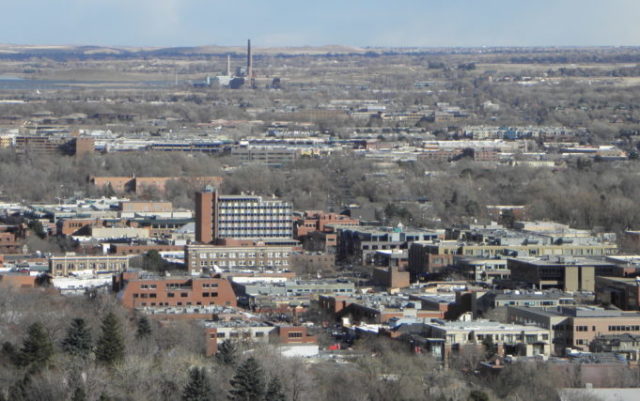
As Enrico Fermi once remarked, “Where is everybody?” According to the latest estimates released by the U.S. Census Bureau, in 2019 the City of Boulder lost population for the third year in a row.
The drop isn’t large. Boulder’s population in 2016 was 107,128; after declines in 2017, 2018 and 2019, it was 105,673, a contraction of 1,455 residents. But that was enough to drop Boulder from 11th to 12th place on the list of Colorado’s largest cities. Greeley, which had been number 12, moved up to number 11.
(The Census Bureau’s annual estimates are for July to July, so the 2019 figure for Boulder’s population is what it was estimated to be as of July 1, 2019.)
Unsurprisingly, Boulder Mayor Sam Weaver and Chamber of Commerce CEO John Tayer see the decline as a bug, not a feature. It’s always like that with growth junkies.
And they think they know what caused it: the geezer-fication of the population (along with high housing costs, of course).
“When a population is aging,” Mayor Sam told the Camera, “you have fewer young people in the home, so that could be one factor. As we get old and people retire and their kids move away, that’s one way you get population decrease.”
Which is kind of reminiscent of Calvin Coolidge’s most memorable economic insight: “When people are out of work, unemployment results.”
And Hizzoner thinks he knows just what it will take to reverse the decline: build some more of the latter-day tenements that the city fathers and mothers are shoehorning into every available nook and cranny in the city while chanting the shibboleths of “affordability” and “diversity.”
Weaver told the Camera that “mixed-use” projects such as the S’park development near 30th and Valmont and The Reve and Boulder Junction projects at 30th and Pearl could help turn the exodus around.
He said the developers of those projects are targeting a demographic that includes Google and Apple tech employees.
“I think as those mixed-use developments continue to come online… we might see those [population] numbers stabilize or reverse because people who are going to move into those mixed-use developments are going to be younger, typically,” he said.
Added Chamber CEO Tayer: “While it’s true that there are some exciting new redevelopment projects occurring, we as the Boulder Chamber are going to continue to advocate for the exploration of redevelopment opportunities in underutilized areas of our community that would create wonderful, vibrant, mixed-use subcommunities.
“It’s fair to assume that we’re seeing that aging of the population and that there are fewer young residents and families that are able to afford Boulder.”
Or want to buy what it has to offer, maybe.
Here’s an alternative explanation for why millennials and Gen Zs, and even Gen Xers are voting with their feet on living in Boulder: Maybe the city isn’t as attractive a place to live as it used to be, due to its hell-for-leather densification.
Maybe people perusing mixed-use projects at 30th and Pearl and 30th and Valmont fail to see the charm of living next to streets that collectively carry 20- to 30,000 vehicle trips a day past their putative future homes.
The ongoing densification of Boulder isn’t producing “wonderful, vibrant, mixed-use subcommunities,” and the city moms and pops are deluding themselves if they think it is. It’s producing a town that is increasingly over-crowded, over-priced, claustrophobic and gagging on its traffic congestion.
The developers of the 30th Street projects are targeting Apple and Google employees — huh? The ones I’ve met are pretty sharp and don’t have much trouble with arithmetic. Maybe they’re asking themselves why buy (or lease) a condo on 30th Street when you can get a larger single-family detached home with a yard in Frederick or Firestone or even Longmont for the same dough? Especially if they have kids or are planning to start a family.
Being able to walk to work is one of the attractions of the 30th Street projects, in theory at least. But while 30th Street may be many things, pedestrian-friendly isn’t one of them.
And it’s not clear that everyone considers living a stone’s throw from their jobs a feature, for any number of reasons.
True, the renderings for both projects are really lovely. So were the renderings for Crossroads — both times it was rebuilt. And both times the end product showed that the renderings were, uh, aspirational.
Weaver and Tayer seem to think that the fact that Boulder hasn’t grown in three years means they should double down on what they have been doing and what, self-evidently, isn’t working, either in terms of improving Boulder’s overall quality of life or growing its population (if that’s what you want). The City would be better off if it took the falling population as a warning. The kind you get from a canary in a coal mine.
This opinion column does not necessarily reflect the views of Boulder Weekly.














